Tuesday, May 19 — Today Christi, John and Andronikos went to Chania. Andronikos has never been there and wanted to see the old Venetian city. Eric was still feeling a bit under the weather, and since the long day yesterday had made him feel worse, he decided it was best to spend the day resting.
When the three of us left Bali, the weather looked a little bit ominous. Shortly after getting on the road, we found ourselves in the middle of a huge storm with heavy rain. However, as we neared the outskirts of Chania, the rain stopped and the sun came out. It was gorgeous out with idyllic temperatures. We lucked out. This time, we found Chania with no problems (last time we got seriously lost) and made a bee-line for the historic district.
The three of us walked around town for a while. In terms of new sights for Christi, we saw some ruins that pre-date the Venetian era on the edges of the historic district. Something that Christi found weird is that some modern buildings share common walls with ancient ruins. She finds that to be almost crazy.
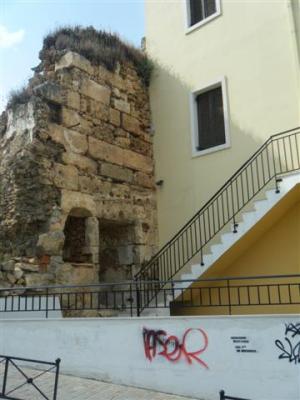
We also went inside the traditional market, a cross shaped building with high ceilings, and wide aisles lined with assorted vendors. Here is a shot of the exterior and interior.
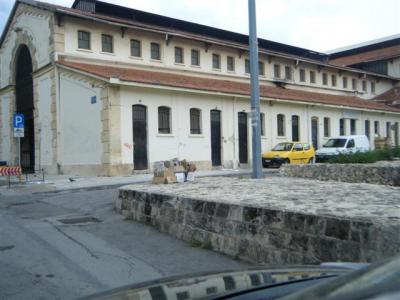
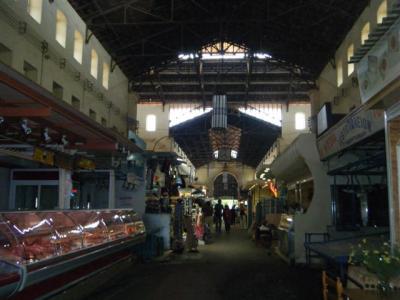
Most vendors sell raw food, with several butchers, produce stalls, and stalls selling things like nuts, olives, olive oil and dried fruit. There were a couple restaurant stalls and a couple stalls selling tourist goods. Despite the tourist stalls, we got the impression this market is meant more for locals than for tourists. These markets, or “stoas“, are a custom that dates back to ancient times. Not just the concept of gathering together in a particular place to conduct commerce, but the type of building and layout that is utilized for that commerce. It kind of awed Christi to think that this market is much the same as the ones we toured in several ancient ruin sites.
Pretty much everything else we saw is the same as what we reported last time we went to Chania. It is still adorable and charming, and the only thing that Christi noticed was different was more graffiti around. Last time, we forgot to mention that most of the ground floors of buildings have been remodeled and are currently in use, but many of the upper floors are still dilapidated shells. It is kind of weird to see a building that is only partially reconstructed. It actually adds another layer of character, the stark contrast of old versus newer in one single building. There are a few buildings that are completely abandoned, but not many. Andronikos told us that the EU pays for much of the restoration cost of these old buildings, which is why there has been a resurgence in gentrifying these old areas in recent years.
Here are a few more shots of the city to enhance the photos from the last Chania post. The first one is of Venetian warehouses along the waterfront that were used in shipping exactly the same as warehouses are used in ports today. You can see them in the background of one of the pictures in last year’s post, but we thought it would be cool to show a close up of them. They have probably been abandoned for hundreds of years, and they are still standing quite nicely, considering. That is quality construction!
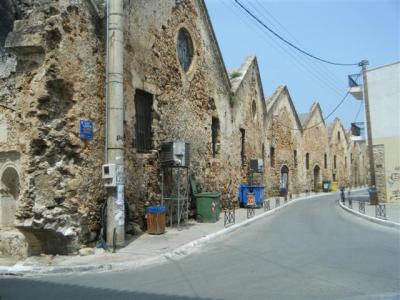
The second shot is a building with exterior walls that are super thick at the bottom and get progressively narrower farther up the wall. They are supposed to withstand being hit by powerful waves better than a regular flat wall does. We had talked about that style of architecture in our “Sheep Shearing Party in Aghia & Rythmeno, Crete“ entry last year, but never posted a photo of one. Better late than never, right?
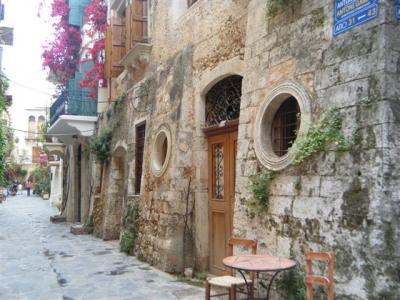
Next is a typical street scene so you can see just how darn narrow the streets are. We had posted one photo of a narrow street last time, and we thought a second one would help give a better sense that all the roads are this narrow.
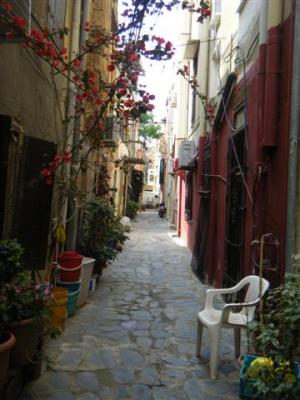
John had been hoping to go to the naval museum, but, sadly, it was closed. Being that Andronikos loves history (it must run in the family, because Christi loves history, too), he really enjoyed all the old buildings, particularly the appointments on the more ornate buildings. However, John has been to Chania several times, so he got bored rather quickly and was tired of walking, so he wanted to leave sooner than Christi and Andronikos wanted to. We compromised, agreeing to drive around town instead of walking. Of course, you can’t drive through this little district, but there were plenty of other things around the city that we could see. Going back to the car turned out to be providential, because as soon as we got inside, the rain storm hit us. We would have been soaked had we gotten back to the car literally two minutes later!
The outskirts of the Venetian waterfront are dotted with assorted old buildings/ruins, and we found many little pockets of old stuff in and amongst the newer and more modern buildings. We mentioned in our last Chania post that only a small bit of the Venetian city wall exists near the historic area. So, we were pretty darn surprised when we saw that several blocks away, the wall picks up again! And this portion of the wall stretches for a long, long way — probably more than a mile. We were kind of surprised that the city limits were as big as they were. It must have been a huge city by that era’s standards.
Near where the wall ended, the beach started. We followed a road that parallels the shore and followed it for a while, enjoying the pretty scenery. We spent a few minutes driving around the more modern parts of town before heading back to Bali for the night.
